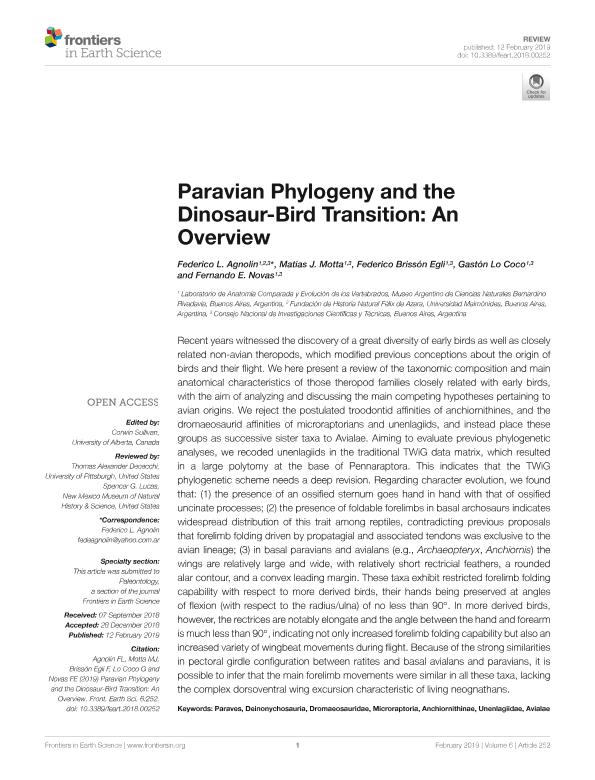Mostrar el registro sencillo del ítem
dc.contributor.author
Agnolin, Federico

dc.contributor.author
Motta, Matias Javier

dc.contributor.author
Brissón Egli, Federico

dc.contributor.author
Lo Coco, Gastón Ernesto

dc.contributor.author
Novas, Fernando Emilio

dc.date.available
2021-04-16T14:40:02Z
dc.date.issued
2019-02
dc.identifier.citation
Agnolin, Federico; Motta, Matias Javier; Brissón Egli, Federico; Lo Coco, Gastón Ernesto; Novas, Fernando Emilio; Paravian phylogeny and the dinosaur-bird transition: An overview; Frontiers Media S.A.; Frontiers in Earth Science; 6; 2-2019; 1-28
dc.identifier.issn
2296-6463
dc.identifier.uri
http://hdl.handle.net/11336/130197
dc.description.abstract
Recent years witnessed the discovery of a great diversity of early birds as well as closely related non-avian theropods, which modified previous conceptions about the origin of birds and their flight. We here present a review of the taxonomic composition and main anatomical characteristics of those theropod families closely related with early birds, with the aim of analyzing and discussing the main competing hypotheses pertaining to avian origins. We reject the postulated troodontid affinities of anchiornithines, and the dromaeosaurid affinities of microraptorians and unenlagiids, and instead place these groups as successive sister taxa to Avialae. Aiming to evaluate previous phylogenetic analyses, we recoded unenlagiids in the traditional TWiG data matrix, which resulted in a large polytomy at the base of Pennaraptora. This indicates that the TWiG phylogenetic scheme needs a deep revision. Regarding character evolution, we found that: (1) the presence of an ossified sternum goes hand in hand with that of ossified uncinate processes; (2) the presence of foldable forelimbs in basal archosaurs indicates widespread distribution of this trait among reptiles, contradicting previous proposals that forelimb folding driven by propatagial and associated tendons was exclusive to the avian lineage; (3) in basal paravians and avialans (e.g., Archaeopteryx, Anchiornis) the wings are relatively large and wide, with relatively short rectricial feathers, a rounded alar contour, and a convex leading margin. These taxa exhibit restricted forelimb folding capability with respect to more derived birds, their hands being preserved at angles of flexion (with respect to the radius/ulna) of no less than 90°. In more derived birds, however, the rectrices are notably elongate and the angle between the hand and forearm is much less than 90°, indicating not only increased forelimb folding capability but also an increased variety of wingbeat movements during flight. Because of the strong similarities in pectoral girdle configuration between ratites and basal avialans and paravians, it is possible to infer that the main forelimb movements were similar in all these taxa, lacking the complex dorsoventral wing excursion characteristic of living neognathans.
dc.format
application/pdf
dc.language.iso
eng
dc.publisher
Frontiers Media S.A.

dc.rights
info:eu-repo/semantics/openAccess
dc.rights.uri
https://creativecommons.org/licenses/by-nc-sa/2.5/ar/
dc.subject
ANCHIORNITHINAE
dc.subject
AVIALAE
dc.subject
DEINONYCHOSAURIA
dc.subject
DROMAEOSAURIDAE
dc.subject
MICRORAPTORIA
dc.subject
PARAVES
dc.subject
UNENLAGIIDAE
dc.subject.classification
Mineralogía

dc.subject.classification
Ciencias de la Tierra y relacionadas con el Medio Ambiente

dc.subject.classification
CIENCIAS NATURALES Y EXACTAS

dc.title
Paravian phylogeny and the dinosaur-bird transition: An overview
dc.type
info:eu-repo/semantics/article
dc.type
info:ar-repo/semantics/artículo
dc.type
info:eu-repo/semantics/publishedVersion
dc.date.updated
2020-11-18T20:13:03Z
dc.journal.volume
6
dc.journal.pagination
1-28
dc.journal.pais
Reino Unido

dc.description.fil
Fil: Agnolin, Federico. Consejo Nacional de Investigaciones Científicas y Técnicas. Oficina de Coordinación Administrativa Parque Centenario. Museo Argentino de Ciencias Naturales "Bernardino Rivadavia"; Argentina. Fundación de Historia Natural Félix de Azara; Argentina
dc.description.fil
Fil: Motta, Matias Javier. Consejo Nacional de Investigaciones Científicas y Técnicas. Oficina de Coordinación Administrativa Parque Centenario. Museo Argentino de Ciencias Naturales "Bernardino Rivadavia"; Argentina
dc.description.fil
Fil: Brissón Egli, Federico. Consejo Nacional de Investigaciones Científicas y Técnicas. Oficina de Coordinación Administrativa Parque Centenario. Museo Argentino de Ciencias Naturales "Bernardino Rivadavia"; Argentina
dc.description.fil
Fil: Lo Coco, Gastón Ernesto. Consejo Nacional de Investigaciones Científicas y Técnicas. Oficina de Coordinación Administrativa Parque Centenario. Museo Argentino de Ciencias Naturales "Bernardino Rivadavia"; Argentina
dc.description.fil
Fil: Novas, Fernando Emilio. Consejo Nacional de Investigaciones Científicas y Técnicas. Oficina de Coordinación Administrativa Parque Centenario. Museo Argentino de Ciencias Naturales "Bernardino Rivadavia"; Argentina
dc.journal.title
Frontiers in Earth Science
dc.relation.alternativeid
info:eu-repo/semantics/altIdentifier/url/https://www.frontiersin.org/article/10.3389/feart.2018.00252/full
dc.relation.alternativeid
info:eu-repo/semantics/altIdentifier/doi/https://doi.org/10.3389/feart.2018.00252
Archivos asociados
